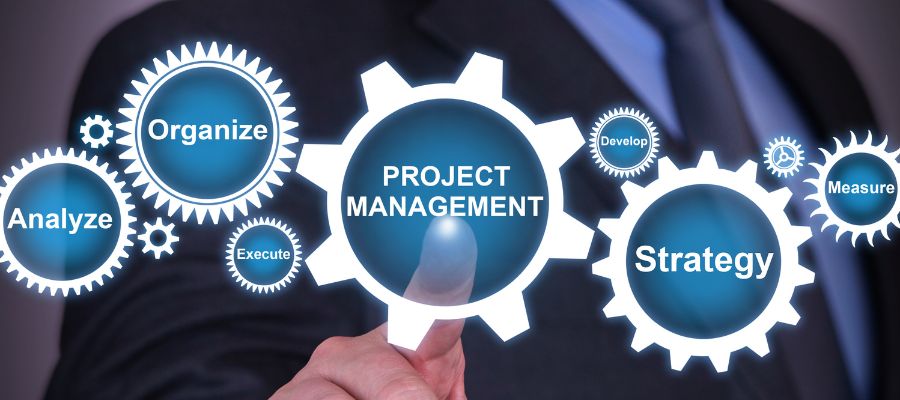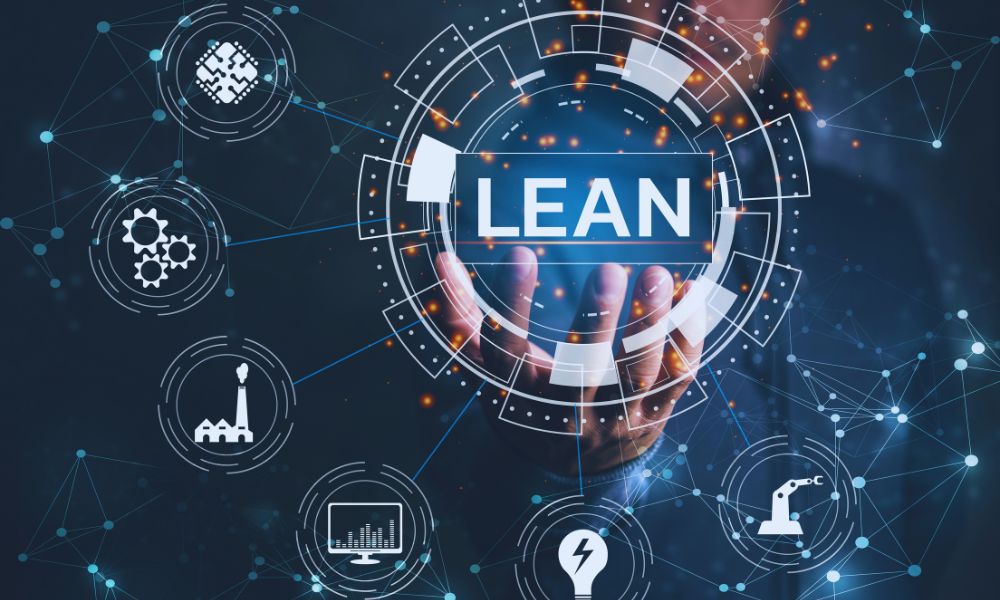Lean Project Management prioritises delivering utmost value to customers while minimising waste, offering an approach to project management. It was inspired by the lean manufacturing principles that Toyota first developed.
The idea is to use fewer resources and eliminate wasteful practices to improve efficiency and quality. This approach is versatile and can be implemented across a wide range of industries, spanning from manufacturing to software development and service sectors.
What Is Lean Project Management?

Lean Project Management is a way of planning and executing projects that emphasises efficiency and value. It seeks to deliver more with less by focusing on what adds value to the customer and eliminating anything that does not.
This approach is grounded in the principles of Lean manufacturing, which aim to reduce waste, improve processes, and deliver better products and services.
Principles of Lean Project Management

Lean Project Management revolves around a core set of principles designed to maximise value and minimise waste. These principles serve as a guide for managing projects efficiently and effectively. Let’s explore each of these principles in more detail:
1. Value
The first principle is to understand what value means to the customer. This involves identifying what the customer needs and values in the product or service being delivered.
By focusing on these needs, project teams can ensure that their efforts are directed toward creating outcomes that matter most to the customer. To achieve this, it’s essential to:
a.) Conduct thorough market research as well as gather customer feedback.
b.) Define clear project goals that align with customer expectations.
c.) Prioritise tasks and features that deliver the most significant impact.
2. Value Stream
Mapping the value stream involves analysing all the steps in the project lifecycle from start to finish.
This helps to visualise the flow of materials, information, and tasks needed to deliver the final product or service. By doing this, teams can:
a.) Identify steps that add value to the project.
b.) Spot activities that are wasteful or unnecessary.
c.) Streamline processes by eliminating non-value-adding activities.
3. Flow
Ensuring a smooth flow means that the project progresses seamlessly without interruptions, bottlenecks, or delays.
A continuous flow is vital for maintaining productivity and meeting deadlines. To create a smooth flow:
a.) Organise work in a way that tasks move through the process without unnecessary waiting times.
b.) Use visual management tools like Kanban boards to track progress and manage workload.
c.) Implement process standardisation to ensure consistency and predictability.
4. Pull
The pull principle involves producing work only when there is a demand rather than pushing work based on forecasts or schedules.
This helps reduce overproduction and minimise inventory. To implement a pull system:
a.) Respond to actual customer demand rather than speculative demand.
b.) Use just-in-time (JIT) production methods to ensure that resources are used only when needed.
c.) Maintain a flexible workflow that can adapt quickly to changes in demand.
5. Perfection
The pursuit of perfection is about continuously improving processes to achieve excellence.
It is based on the belief that there is always room for improvement, no matter how well the process is performed. To strive for perfection:
a.) Encourage a culture of continuous improvement (Kaizen) where all team members are involved in suggesting and implementing improvements.
b.) Regularly review and refine processes to eliminate waste and enhance efficiency.
c.) Set high standards and benchmarks to motivate teams to aim for the best possible outcomes.
Lean Project Management Tools

Lean Project Management employs various tools to help teams streamline their workflows, improve efficiency, and eliminate waste. Here are some of the most commonly used tools:
1. Kanban
Kanban serves as a visual aid in project management, aiding teams in organising workflow by presenting tasks on a board. Typically, this board is sectioned into columns, each denoting various stages of the process, like “To Do,” “In Progress,” and “Done.”
Tasks are depicted as cards and transition through these columns as work advances. The key benefits of Kanban include:
a.) Visualisation
Provides a clear picture of the workflow, making it easy to see the status of each task.
b.) Flexibility
Allows teams to adapt quickly to changes and prioritise tasks effectively.
c.) Limiting Work in Progress (WIP)
Helps prevent bottlenecks by limiting the number of tasks in progress at any time, ensuring a smooth workflow.
d.) Continuous Improvement
Encourages regular evaluation and adjustment of processes to enhance efficiency and productivity.
By using Kanban, teams can maintain better control over their projects, quickly identify and address issues, and continuously improve their processes.
2. Value Stream Mapping
Value Stream Mapping (VSM) is a technique used to visualise and analyse the steps involved in delivering a product or service.
It maps out the entire process from start to finish, identifying each step and categorising it as either value-added or non-value-added. The key benefits of Value Stream Mapping include:
a.) Identifying Waste
Helps pinpoint inefficiencies and waste in the process, such as delays, excessive movement, or redundant steps.
b.) Improving Flow
Provides insights into how the workflow can be streamlined to make sure a smooth and continuous process.
c.) Enhancing Communication
Serves as a visual communication tool that helps teams understand the process and collaborate on improvements.
d.) Basis for Continuous Improvement
Forms the foundation for continuous improvement efforts by highlighting areas for optimization.
By using Value Stream Mapping, organisations can gain a clear understanding of their processes, identify opportunities for improvement, and create more efficient workflows.
3. 5S
5S is a workplace organisation method that aims to improve efficiency and safety through five key steps: Sort, Set in order, Shine, Standardise, and Sustain.
Each step focuses on creating an organised, clean, and standardised work environment. The key benefits of 5S include:
a.) Enhanced Efficiency
Reduces the time and effort needed to find tools and materials by keeping everything organised and in its proper place.
b.) Improved Safety
Minimises hazards by maintaining a clean and orderly workspace.
c.) Standardisation
Ensures consistency in work processes, making it easier to maintain high-quality standards.
d.) Sustained Improvements
Encourages a culture of continuous improvement by regularly reviewing and refining workplace organisation practices.
Implementing 5S helps teams create a more efficient and safe work environment, leading to increased productivity and reduced errors.
4. Kaizen
Kaizen is a philosophy advocating continuous improvement, encouraging all employees to engage in the process, from management to frontline workers, to suggest and implement small, incremental changes. The key benefits of Kaizen include:
a.) Employee Engagement
Involves all team members in the improvement process, fostering a sense of ownership and collaboration.
b.) Continuous Improvement
Focuses on making small, regular improvements that cumulatively result in significant enhancements over time.
c.) Problem Solving
Encourages proactive identification and resolution of issues, leading to more efficient and effective processes.
d.) Cultural Shift
Promotes a culture of continuous learning and development, where employees are always looking for ways to improve.
By embracing Kaizen, organisations can continually refine their processes, boost efficiency, and cultivate an environment that encourages innovation and collaboration.
Lean Project Management Software

Lean project management software tools, including power BI consulting services, are designed to support the principles and practices of Lean Project Management.
These software solutions often include features such as Kanban boards, Value Stream Mapping, task tracking, and analytics. The key benefits of Lean project management software include:
1. Enhanced Collaboration
Provides a centralised platform where team members can collaborate, share updates, and track progress in real-time.
2. Better Visibility
Offers visual tools and dashboards that give a clear overview of the project status, helping teams make informed decisions.
3. Efficient Task Management
Automates task assignment, tracking, and prioritisation, ensuring that resources are used efficiently.
4. Data-Driven Insights
Provides analytics and reporting features that help teams identify trends, measure performance, and continuously improve their processes.
Using Lean project management software helps teams streamline their workflows, improve communication, and enhance overall project management efficiency.
Why Lean Management Is Important

Lean management is important because it helps organisations deliver better products and services more efficiently.
By focusing on what adds value to the customer and eliminating waste, companies can improve quality, reduce costs, and increase customer satisfaction.
Improve Your Workflow with Lean Project Management

To enhance your workflow using Lean Project Management, begin by pinpointing areas where inefficiencies exist. This could be in the form of unnecessary steps, excessive waiting times, or overproduction.
Once you identify these areas, use lean project management tools like Kanban and Value Stream Mapping to streamline your processes. Engage your team in regular Kaizen sessions to encourage continuous improvement and gather ideas on how to make your workflow more efficient.
For further support in implementing lean methodologies, consider seeking assistance from professionals in software consulting services to ensure effective integration and sustainable improvement.
Benefits of Lean Project Management

Lean Project Management offers a multitude of advantages that can significantly enhance the efficiency as well as effectiveness of an organisation. Here are some key benefits:
1. Increased Efficiency
By focusing on value-added activities and eliminating waste, Lean Project Management helps teams complete tasks faster and more effectively. This leads to smoother workflows and less time wasted on non-essential activities.
2. Cost Reduction
Eliminating wasteful practices not only saves time but also reduces costs. By streamlining processes and improving resource utilisation, organisations can lower their expenses and increase profitability.
3. Enhanced Customer Satisfaction
By prioritising customer value and ensuring products, services, and customer support systems meet or exceed expectations, Lean Project Management leads to higher levels of customer satisfaction. Timely delivery of high-quality outputs enhances the overall customer experience.
4. Better Resource Management
Lean Project Management promotes the efficient use of resources, ensuring that time, money, and materials are used effectively. This results in better project outcomes and more sustainable operations.
5. Flexibility and Adaptability
Lean Project Management methodologies, such as Kanban, allow teams to adapt quickly to changes in demand or project requirements. This flexibility is crucial in dynamic environments where responsiveness is key to success.
6. Clearer Processes
By mapping out value streams and visualising workflows, Lean Project Management helps teams understand their processes better. This clarity enables more effective planning and execution, reducing errors and improving coordination.
7. Sustainability
Lean principles encourage the reduction of waste and the efficient use of resources, contributing to more sustainable business practices. This can have positive environmental impacts and align with corporate social responsibility goals.
By leveraging lean project management software and methodologies, businesses can integrate Lean principles into their operations, achieving these benefits and driving overall improvement.
Engaging with project management consulting services can further help in aligning Lean practices with strategic business goals, ensuring sustained success and competitiveness.
How Lean Project Management Works

Lean Project Management works by applying its principles and tools to manage and improve project workflows. Here’s a step-by-step look at how it typically works:
1. Identify Value
Determine what the customer values and what the project aims to deliver.
2. Map the Value Stream
Analyse the current workflow and identify all the steps involved. Highlight steps that add value and those that don’t.
3. Create Flow
Organise the workflow to ensure smooth and uninterrupted progress. Use tools like Kanban boards to visualise the flow of tasks.
4. Establish Pull
Implement a pull system where work is done only when there is demand. This helps avoid overproduction and reduces waste.
5. Seek Perfection
Regularly review and improve processes. Engage the team in Kaizen activities to find and implement small improvements continuously.
Conclusion
Lean Project Management is an essential methodology for businesses aiming to improve efficiency, quality, and customer satisfaction. By focusing on value delivery and waste reduction, organisations can achieve better outcomes with fewer resources.
Tools like Kanban and Value Stream Mapping, combined with a culture of continuous improvement, make Lean Project Management effective across various industries.
For businesses seeking to integrate these principles, consulting firms like Walter & Associates can provide valuable expertise and support, ensuring that Lean practices align with overall business strategies for optimal growth and success.























